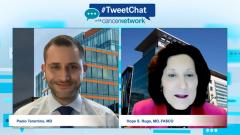
Future Outlook for Treatment of HER2-Low and Triple-Negative Breast Cancers
Hope S. Rugo, MD, FASCO, and Paolo Tarantino, MD, offer closing remarks on the growing field of HER2-low and triple-negative breast cancer.
Episodes in this series

Transcript:
Paolo Tarantino, MD: The takeaway from all this is that we have many new options. We have this new problem deciding what to use. We’ve never had this. All these choices are good to have because you can adapt treatment. You can have treatments that are active. It’s the start of something. In the next few years, we’re going to see several new phase 3 trials, hopefully showing that ADCs [antibody-drug conjugates], even when used in earlier lines, can bring benefits. Hopefully there will be other types of drugs. ADCs are 1 of several promising compounds being used. There are some histology-agnostic approvals. It’s not common to detect NTRK fusions or these alterations, but that happens sometimes, so it’s worth it to genomically profile patients to provide any potential option for the patient.
Hope S. Rugo, MD, FASCO: Absolutely, although I have yet to see an NTRK-fusion gene, and I’ve seen microsatellite instability in only 1 second-opinion patient. I do see tumor mutational burden–high, but primarily in patients with lobular cancer and occasionally in triple-negative breast cancer. These are important things to look at: somatic mutations that we can target. ADCs are an exciting area. How we’re using them continues to change as we learn more, but we have highly effective drugs. We have phase 3 data with sacituzumab and interesting exploratory data with DESTINY-Breast04 [DB-04 trial] in the triple-negative, HER2 [human epidermal growth factor receptor 2]–low populations. More drugs are coming on to the scene all the time and are being studied.
These drugs have enormous efficacy in the largest population. We treat hormone receptor–positive breast cancer. That’s exciting with approval of sacituzumab, and also the approval in summer 2022 of trastuzumab deruxtecan based on DB-04. That’s a rapid turnaround. The thing that’s incredibly striking is that coming from decades ago, we thought we’d never achieve survival differences in metastatic disease. It was an elusive end point. To see all these drugs showing not just PFS [progression-free survival] benefits and response but also survival benefits is incredible. We’re hoping to treat it earlier. We don’t want to be in the metastatic setting if we can avoid it. That’s the long-term goal. Seeing neoadjuvant and post-neoadjuvant trials develop is exciting, and this conversation has highlighted that.
It’s been great to talk to you about all these great areas. I also want to credit you with putting HER2 low on the map, largely outside the trial. You’ve done a huge amount of work to bring together data sets, look at the prognostic impact, educate people about HER2 low, and bring collaborators together internationally. It’s very impressive. Thank you for your work on that.
Paolo Tarantino, MD: Thank you so much, Hope. I can’t credit you enough for being part of most of the studies we’ve been talking about. You’ve had a major impact on the field in every subtype of breast cancer, so thank you for that. Thank you for chairing this program. Thank you for Cancer Network®for having us. Bye, everybody. Thank you for attending this presentation.
Hope S. Rugo, MD, FASCO: Thank you for listening to us.
Transcript edited for clarity.
Newsletter
Stay up to date on recent advances in the multidisciplinary approach to cancer.




















































































